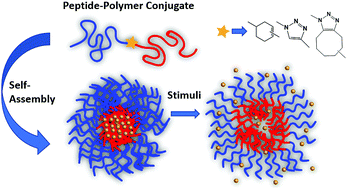Responsive hybrid (poly)peptide–polymer conjugates
Abstract
(Poly)peptide–polymer conjugates continue to garner significant interest in the production of functional materials given their composition of natural and synthetic building blocks that confer select and synergistic properties. Owing to opportunities to design predefined architectures and structures with different morphologies, these hybrid conjugates enable new approaches for producing micro- or nanomaterials. Their modular design enables the incorporation of multiple responsive properties into a single conjugate. This review presents recent advances in (poly)peptide–polymer conjugates for drug-delivery applications, with a specific focus on the utility of the (poly)peptide component in the assembly of particles and nanogels, as well as the role of the (poly)peptide in triggered drug release.

- This article is part of the themed collections: Recent Review Articles and Celebrating Excellence in Research: Women of Materials Science


 Please wait while we load your content...
Please wait while we load your content...